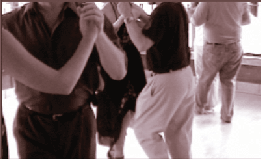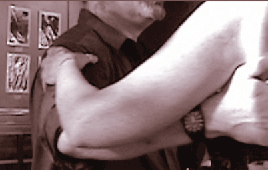
HOME
PUBLISHER’S CORNER
“A SENSORY BRIDGE TO GLOBAL CULTURE”
“…in tango there is a significant emphasis on each person’s space: respecting the other’s space yet coming into it at times, resisting, keeping one’s space – enough, not too much…In dance this is referred to as ‘the frame’ or ‘keeping your shape/form’ by not allowing the leader to ‘deform’ you.”
One example of this was a tango workshop participant who was finally able to relax her whole body once she discovered she could adjust the space between her and her partner with more or less resistance in her arms.20
Psychologically speaking, the aforementioned dancer may have seen this as a relational metaphor. Once she was able to set safe relationship boundaries for herself by allowing her partner to come closer or further away as she felt comfortable, she could allow herself to be at ease. Discovering this power decreased her resistance to the relationship and may have been an inroad to an increased connection.
Tango has the ability to magnify a person’s patterns, fears, and conflicts surrounding intimate relationships. As she identified in her workshops, Hawkes described the numerous therapeutic issues of relating that may emerge through the tango vehicle. Fear of merging, fear of the ensuing separation, and issues towards guiding, deciding, following, and trusting are a few of the potential conflicts surrounding one’s relational capacity.
Hawkes relayed how one of her workshop participants tearfully described the unbearable pain of being separated from one tango partner after another. Julie Taylor, an anthropologist at Rice University who studied the tango in Buenos Aires on a Guggenheim Fellowship, said that aside from tango “I have never done anything where I’ve felt so emotionally exposed.”21
Jeanne Castle, a dance/movement therapist, expands on this by describing her experiences during tango milongas:


Advertise in:

AS WE INAUGURATE
TANGO LIFE & NEWS
TAKE ADVANTAGE OF OUR EXCLUSIVE
ONE-TIME OFFER TO PLACE YOUR AD HERE
FREE DURING NOVEMBER!
ADVERTISERS, DON’T MISS THIS CHANCE TO FEATURE
YOUR BUSINESS IN PREMIUM WEB SPACE
THAT WILL BE SEEN BY A GLOBAL AUDIENCE!
FOR DETAILS.
312.287.8406
AS A SPECIAL INTRODUCTORY BONUS, YOU’LL ALSO RECEIVE A DISCOUNT ON ADS PLACED THROUGH JANUARY 6, 2011.

THE S P A C E BETWEEN US
PSYCHOLOGICAL PERSPECTIVES
ON THE DANCE OF RELATIONSHIP

THE S P A C E
BETWEEN US
CONTINUES...CLICK HERE
CONTINUED
LIBERATING AND THREATENING ASPECTS OF TANGO
The third phase of an erotic encounter is closure and integration. Once both partners feel a sense of completion in their exchange, another shift occurs where the intensity dies down and the two selves within the partnership begin to separate into their respective entities. The thinking mind now rises to the surface attempting to integrate the experience with sense of self. Partners may offer loving words or gestures to express their feelings to one another about the exchange.19
In tango, the music clearly signals the completion of the dance. Milongas (social dances) typically feature a “set” of three or four consecutive dances called a tanda, during which it’s polite to continue dancing until the cortina, or signaled end of that set. Partners may opt to dance consecutive tandas until the “conversation” feels truly complete.
Tango dance etiquette concludes with mutual expression of appreciation and the man escorting the woman back to the sidelines with a gentlemanly touch of her elbow, back or hand. This facilitates closure of the intimacy just shared and a chance to reflect on the experience before a new dance begins, or even take breaks between partners.

a safe container. Hawkes elaborates on several ways that this happens.
Although there’s plenty of room for freedom and improvisation, the structure of the dance and the music serves to contain the interaction. While dancing tango “in a way that is repeated, foreseeable, and reassuring, we have a possibility of becoming close…and the certainty of separating thereafter as well as the possibility of connecting again.” The social aspect of the dance, where the dyad is a part of a larger group, aids in offering even more protection.
Perhaps most importantly, Hawkes described how the physical boundaries of tango allow for healthy exploration of connection and separation:
While the tango shares many attributes with a sexual encounter, it is not one, and therefore it offers one the ability to explore intimacy within
“Suddenly the substrata of my adult personality begin to shift like tectonic plates underlying my social composure. These deep layers of my psyche and soma are moving with the pressures of desire, fears fueled by my essential loneliness, defenses mobilizing with my unconscious, destabilizing dreads of rejection. Although I appear to be a mature woman – slender, in a form fitting top and skirt with slits up the sides, standing in four inch heels – I am also a baby girl who has not yet consciously become herself, as I softly allow by body to be swept into my partner’s embrace. The embrace of the moment awakens the original embrace of my infancy, along with all the densities that have ever surrounded the longing for that embrace.”22
Outside the safety of a dance class, milongas pose the added dimension of being chosen or not chosen for a dance. In addition to issues of rejection and exclusion that may emerge from this, attachments made during these intimate exchanges can open the door to jealousy as well.
While these experiences offer the opportunity for tremendous interpersonal growth, they also contain the hazard of inhibiting progress or completely scaring away the dancer. Since connection between mental and emotional attitude and subsequent physical execution are so inescapably linked in tango, the dance requires internal transformation in order to be externally danced well. For this precise reason Hawkes calls for the marriage of psychotherapy and tango in order to move through and process the emotional blocks and resistances that emerge.

